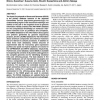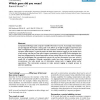221 search results - page 40 / 45 » Extracting and Explaining Biological Knowledge in Microarray... |
NIPS
2007
14 years 5 days ago
2007
Much of human knowledge is organized into sophisticated systems that are often called intuitive theories. We propose that intuitive theories are mentally represented in a logical ...
BIOINFORMATICS
2005
13 years 10 months ago
2005
Motivation: direct bearing whose expres Sorlie et al., 2 gene sets is a diseases (Lossos et al., 2004; Miklos and Maleszka, 2004), and the variables that could account questions i...
NAR
2002
13 years 10 months ago
2002
The Kyoto Encyclopedia of Genes and Genomes (KEGG) is the primary database resource of the Japanese GenomeNet service (http://www.genome.ad.jp/) for understanding higher order fun...
BMCBI
2008
13 years 11 months ago
2008
Background: Although the UniProt KnowledgeBase is not a medical-oriented database, it contains information on more than 2,000 human proteins involved in pathologies. However, thes...
BMCBI
2005
13 years 10 months ago
2005
Computational Biology needs computer-readable information records. Increasingly, meta-analysed and pre-digested information is being used in the follow up of high throughput exper...


